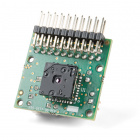
So I replaced it with a Teensy 3.2 hoping it would have enough resources to successfully interface to the Lepton. Unfortunately after soldering the Teensy to a Sparkfun breakout board I stressed the processor BGA package and made the board unreliable. You'll know you have it the right way up when the silkscreen writing "Useful Sensors Person Sensor V1.0" is at the correct orientation. The Lepton 3.5 can output absolute temperature data (Radiometric) at 160x120 pixel resolution. You should be able to see the side of the board that has the sensor by spotting the small lens in the center. Note: The sensor uses an image sensor internally, so you need to make sure that the lens has a clear field of view, and that it's mounted the right way up. Pre-programmed microcontroller - firmware flashing & model updates not available.Module designed for privacy - resistant to allow access to raw image data, only metadata derived from each frame available.Image scan rate - 5Hz with facial recognition active.


Image scan rate - 7Hz with no facial recognition SparkFun KIT-159498 Radiometric Lepton Development Kit includes a breakout as well as the Lepton 2.5 Long-Wave Infra-Red (LWIR) imager. The FLIR® Lepton® Adapter Module allows your OpenMV Camera to interface with the FLIR® Lepton® (version 1, 2 or 3) Thermal Imaging sensors for Thermal Vision applications.This reduces the amount of required PCB space, and polarized connections mean you can't hook it up wrong. All Qwiic-enabled boards use a common 1mm pitch, 4-pin JST connector. The SparkFun Qwiic Connect System is an ecosystem of I 2C sensors, actuators, shields and cables that make prototyping faster and less prone to error. The Person Sensor is designed to be a simple way to build smarter devices.

This makes it easy to build projects that wake up when people approach, follow their faces, mute a microphone when nobody is present, and even recognize different people to personalize their experiences. It is a small, low power (~150 milliwatts), and economical hardware module that is capable of detecting nearby faces and returning information about how many there are, where they are relative to the device, and performs facial recognition. Internally the Person Sensor bundles an image sensor and a small microcontroller into a single board. There's also a separate interrupt pin, TP1, which is used to indicate if any people have been detected. It is designed to be used as an input to a larger system and be treated like any other sensor where power and information are provided through SparkFun's Qwiic I 2C interface.


 0 kommentar(er)
0 kommentar(er)
